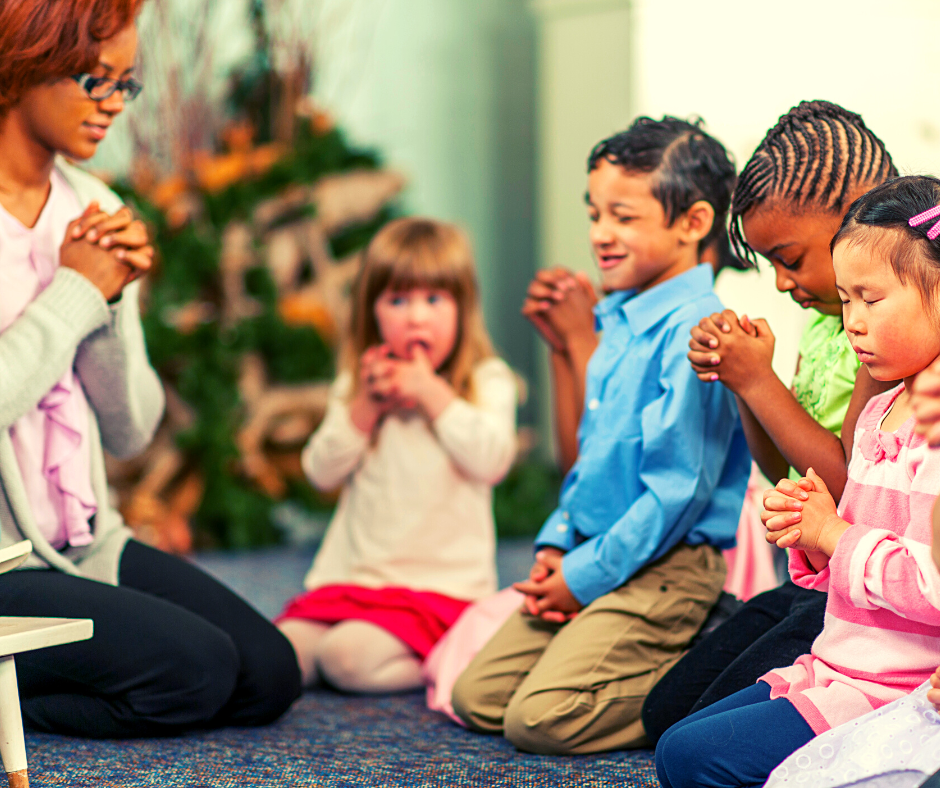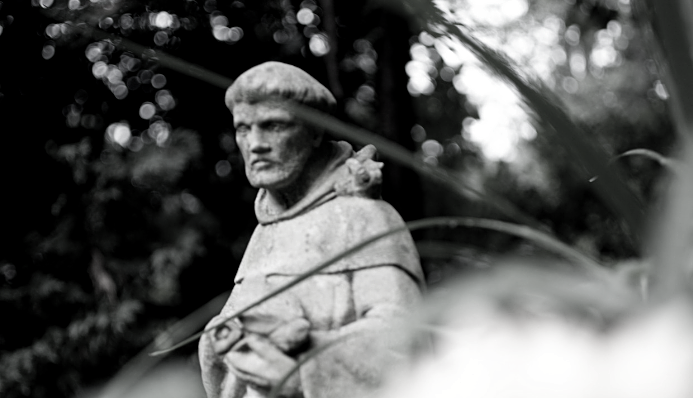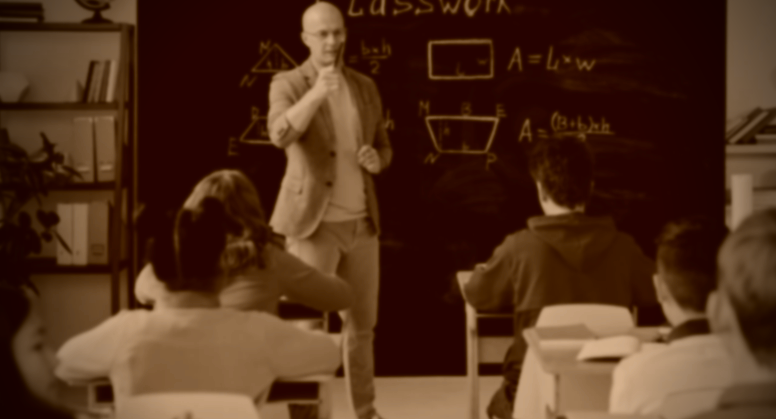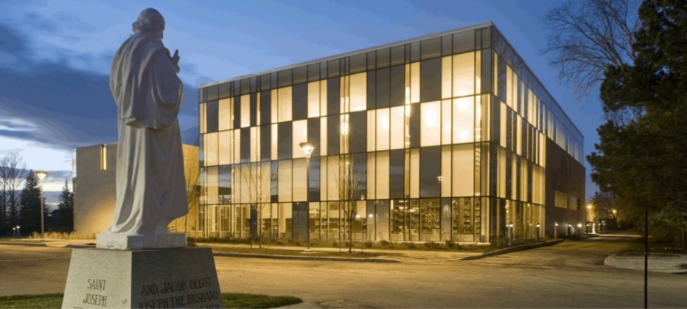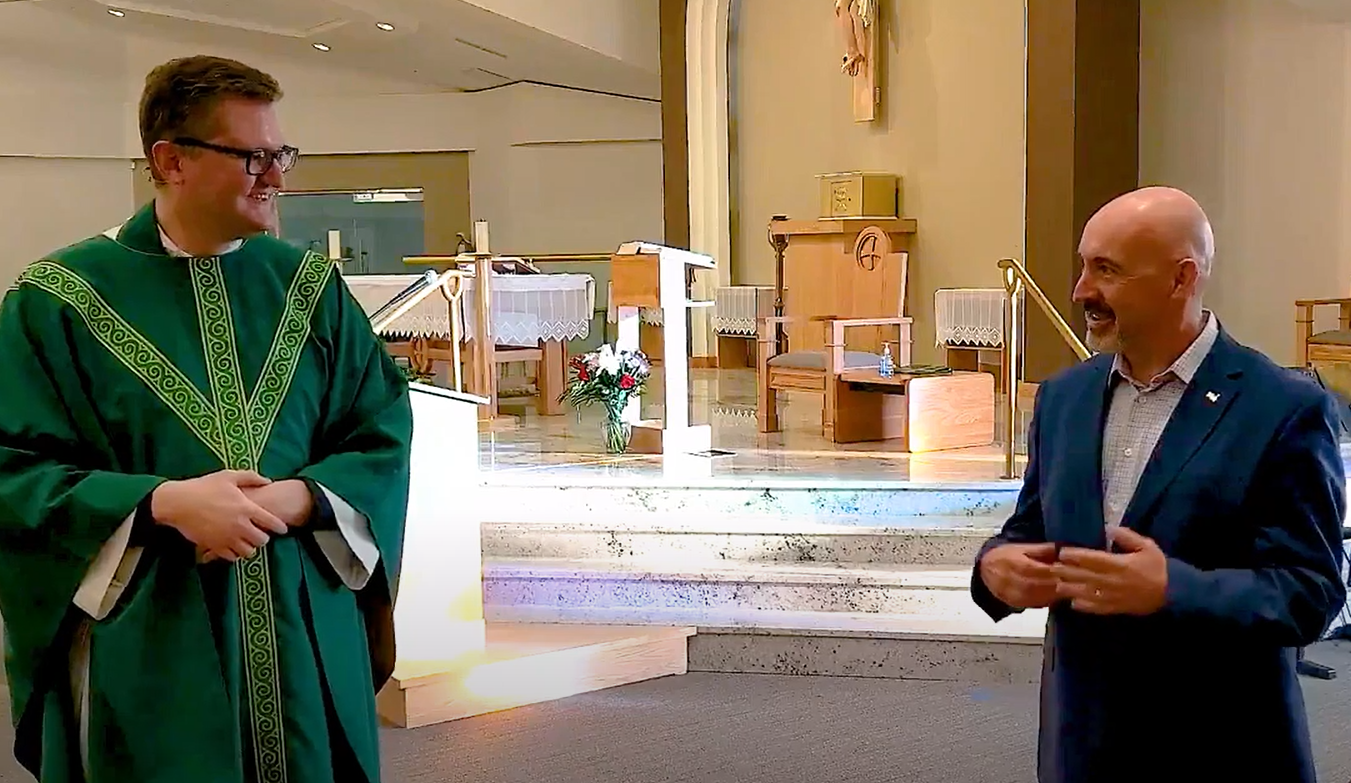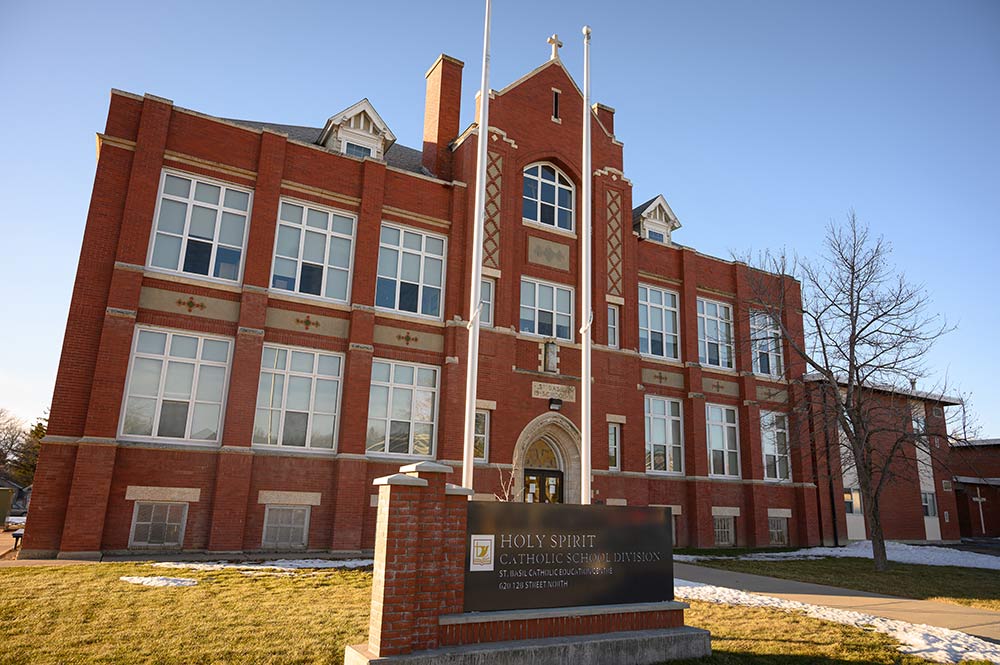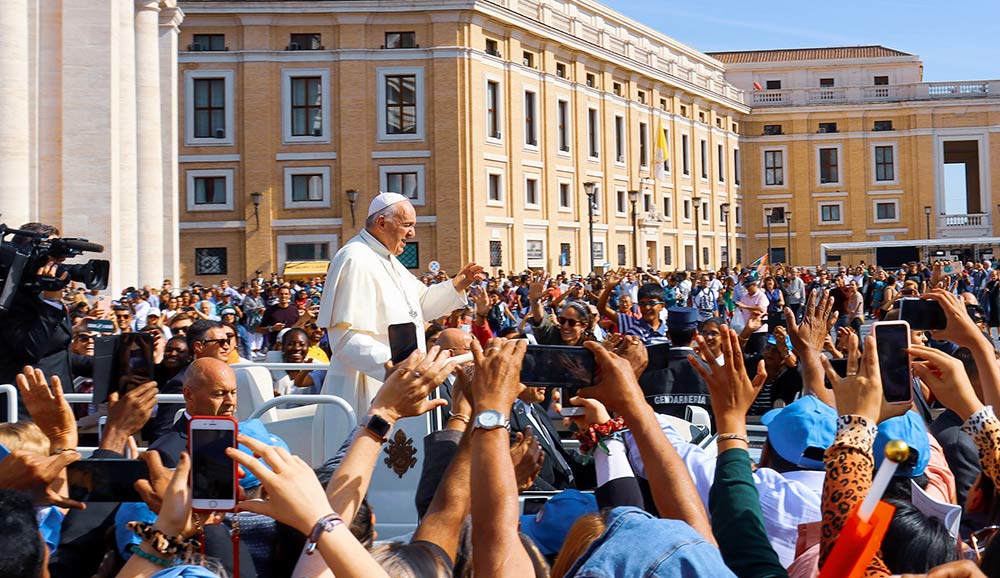- Details
- Written by Brett Fawcett
- Category: Education Philosophy
The reason why the Church teaches that Catholics should send their children to Catholic schools whenever possible, and the reason why Alberta’s constitution protects the right of Catholics to have their own separate schools, is because the purpose of Catholic education is to form young people in obedience to Christ and to show how Jesus is Lord over every corner of the universe. Achieving this goal requires having a school–one where everything about that school points students towards God. The word usually used to describe this is “permeation,” though some school authorities prefer “integration.”
However, despite how commonly “permeation” appears in magisterial documents and in school policy, finding a succinct, handy definition is surprisingly difficult. This leaves a couple of important questions open:
- What exactly are we permeating?
- What exactly are we permeating it with?
Take an English class that opens and closes with the Our Father. Is this permeation? Or take a Biology class where the teacher mentions that Gregor Mendel, the founder of genetics, was an Augustinian friar. Would this qualify as permeation? One is an example of school ethos being given a Catholic aspect; the other is a bit of instructional information which makes a Catholic connection. These are two different aspects of school life into which a Catholic component has been included, though one is spiritual and one is more cerebral. So, which is it? Is permeation about infusing Catholic spirituality into the atmosphere, or about infusing Catholic content into the study materials?
Or–to put it a bit differently–suppose these are both examples of permeation. We have mentioned that, in one sense, the purpose of having Catholic schools is permeation. If the teachers include these elements, have they permeated “enough”? How much prayer is “enough” to permeate? How many Catholic-relevant facts are “enough” to include in a lesson before it is sufficiently permeated?
These are important questions because, in our secular age, the Catholic school (and the Catholic university) may be the only major avenue for generating a Catholic culture, and is probably the most important location of Catholic evangelization. Not only is Catholic formation not coming in any great measure from entertainment, media, social organizations, or government, but, sadly, it is also largely absent from Catholic homes, leaving the school as perhaps the only opportunity for the next generation to learn how to love the Lord their God with its heart, soul, mind, and strength.
(We can perhaps take comfort in the fact that this is not the first time this has happened. In the fourth century, St. John Chrysostom complained that parents took care to train their children in arts and literature but completely neglected to bring them up in the faith, and the Catholic Encyclopedia notes that it was “no longer possible for children to obtain proper religious and moral training in their own homes” is what gave rise to the monastic schools, forerunners of the Catholic schools of today.)
This culture and this formation will only develop if permeation is achieved. Therefore, let’s pay close attention to how the Magisterium uses the word in its official documents on education.
What we find is that it seems to be used in two different senses.
One use of “permeation” uses it to refer to the intentional integration of Catholicism into classrooms and explicit instruction. Since this is what it meant in its first appearance in Church teaching (paragraph 80 of the 1929 encyclical Divini Illius Magistri), we can consider this the original and primary sense of what permeation is. It is also how Vancouver Archbishop Miller uses the word when he includes it in The Five Essential Marks of Catholic Schools as the fourth mark: “Imbued With a Catholic Worldview Throughout Its Curriculum.”
However, in most of the documents from the Congregation for Catholic Education, “permeation” refers to how the entire ethos, including the relationships between staff members, should exude a Christian spirit of, as Vatican II’s Declaration on Christian Education, Gravissimum Educationis, puts it, “freedom and charity”. Now, it is obviously true that a Christian school’s atmosphere should be permeated by a sense of Christian devotion and love. However, this is also true of a parish office, a Catholic soup kitchen, or even a business with Catholic employees. There doesn’t seem to be anything specifically educational about this kind of permeation.
Moreover, when it comes to what exactly we are permeating schools with, these references are still frankly a bit nebulous. What exactly does “piety” or “the Gospel spirit” look like in a school? Won’t this look different depending on what aspect of school life is being permeated?
I think it would be helpful if we first distinguished different forms of permeation. Paragraph 2 of Gravissimum Educationis can serve as our guide. It explains the nature of Christian education this way:
“A Christian education does not merely strive for the maturing of a human person as just now described, but has as its principal purpose this goal: that the baptized, while they are gradually introduced the knowledge of the mystery of salvation, become ever more aware of the gift of Faith they have received, and that they learn in addition how to worship God the Father in spirit and truth (cf. John 4:23) especially in liturgical action, and be conformed in their personal lives according to the new man created in justice and holiness of truth (Eph. 4:22-24); also that they develop into perfect manhood, to the mature measure of the fullness of Christ (cf. Eph. 4:13) and strive for the growth of the Mystical Body; moreover, that aware of their calling, they learn not only how to bear witness to the hope that is in them (cf. Peter 3:15) but also how to help in the Christian formation of the world that takes place when natural powers viewed in the full consideration of man redeemed by Christ contribute to the good of the whole society.” (emphasis added)
We could boil this down to three major goals; or, to use curricular language, outcomes. Students at Catholic schools should graduate with:
- A deeper knowledge of the Faith
- A deeper awareness of how to worship God
- A deeper understanding of how to live in a Christian way in society
With this as a framework, I would suggest we can recognize three different forms of permeation. For mnemonic purposes, these can be categorized with three words starting with the letter “w”: worldview permeation, worship permeation, and witness permeation.
- Worldview permeation could also be called theological permeation or intellectual permeation. This refers to teaching students how to think about the universe in a way that is informed by the revelation of Jesus Christ. The teachings of the Church have implications for how history, physical science, literature, and even mathematics are interpreted. If any subject is taught without reference to God, the implication is that God is irrelevant to that subject. On the other hand, an integrated Catholic worldview will have a perspective on evolution, on artificial intelligence, on different economic systems, and on every other topic in creation, all of which are logical deductions from the Creed. The Catholic intellectual tradition should shape our entire curriculum, and students should have an integrated and coherent worldview, rather than one which professes acceptance of Christian teaching alongside total inconsistent acceptance of secular views about sexuality and society or materialist views about cosmology. This obviously requires a robust intellectual formation of teachers, and perhaps the Catholic community needs to have a serious conversation about the kind of pre-service training Catholic teachers should receive.
- Worship permeation could also be called spirituality permeation or prayer permeation. The ultimate goal of Catholic schools, and of all Catholic activity, is to know and love God. It is more important to get into heaven than college. Although salvation is by God’s grace, Catholic schools have the task of forming students so that they are open to that grace by knowing how to speak to God and how to listen to God in the way that He has revealed to us that we should. This does not just mean prayers at the beginning of class, or school liturgies–although these are indispensable. It also means that the awe students experience when learning about the beautiful intricacies of the universe should blossom into praise of its Creator. It means the stress and suffering they experience in preparing for examinations should be offered up with Christ’s suffering on the Cross. It means that breathing exercises should not be a simple internal silence but a silence that waits for God’s Word; it should be more like centering prayer than Buddhist meditation. And, when students are struggling with making decisions, they should have been taught to ask God for His guidance and to discern His will carefully (and how). Again, this should be present in every class at a Catholic school, even if it means finding or writing opening and closing prayers for a lesson that are relevant to the curriculum (“thank you, God, for creating trees”).
- Witness permeation could also be called morality permeation or praxis permeation. This refers to teaching students to live out the ethical obligations of being in communion with God. If worldview permeation relates to knowing about God, and worship permeation relates to loving God, witness permeation relates to loving one’s neighbour. This relates to both personal and communal morality. Students should learn fortitude and self-control (physical education can play an important role here) in order to master concupiscence in cooperation with grace and should be trained to be responsible and proactive citizens who use the knowledge they received from science and social studies classes to implement Catholic Social Teaching in the world. (Again, there is no subject where the behaviour of the students will be completely irrelevant. The question, “What can students do with this information?” should always be lurking, and the answer should always be some variation on “they can use it to serve God and others.”)
When teachers ask, “Have I permeated enough?”, this could be a useful checklist for them: “Have I taught my students how to interpret this information in the light of the Faith?” “Have I used what I am teaching to direct my students towards God in prayer and worship?” “Have I taught my students how they can use this content in a moral and loving way?”
Do all three forms of permeation need to be present at all times? In all likelihood, not every lesson will necessarily lend itself to this. However, it’s worth noting that, if done correctly, each form of permeation should implicitly contain the other two. Good spiritual practices and just social action should teach students to have correct theology: Lex orandi, lex credendi (“the law of prayer is the law of faith”). On the other hand, correct theology, and the breathtaking impressive scope of the Catholic intellectual tradition, should inspire students to want to adore God and to love and serve others. Orthodoxy inspires orthopraxy.
So, if this is what we are permeating with, what exactly are we permeating? Are lessons being permeated, or is the whole ethos of the school being permeated? As I mentioned, the original definition of permeation was that it had to do with curriculum. I think this has to continue to be its primary meaning. However, as every teacher knows, there are at least two kinds of curriculum: The explicit curriculum and the implicit curriculum. The explicit curriculum is what is overtly taught, but the implicit curriculum is what is indirectly taught. It is the lessons and messages the school sends to students by the way it acts, by what it treats as being important, by its general “vibe.” If a Catholic school is permeated with a Gospel spirit of freedom and charity because its staff are imitating Christ in the way they work with each other, that is itself a lesson to the students at that school about what it means to be a Christian. In that sense, all five marks of a Catholic school are a form of permeation.
Therefore, I would propose a second way of distinguishing permeation: Explicit curriculum permeation and implicit curriculum permeation. This could be another kind of checklist for teachers: Not only, “What have I taught today in my instructional activities?,” but also, “What have I taught today by my actions?” In building relationships with my students, have I modeled Christ’s love that calls on us to care even for the most difficult lost sheep (as Dorothy Day put it, “I really only love God as much as I love the person I love the least”)? In dealing with my own frustrations, have I fallen back on prayer and forgiveness in a way that models Christlikeness? In my conversations with my colleagues (and are there ever any truly private conversations at a school), have my comments not only demonstrated Christian charity but also demonstrated intellectual consistency with the Church’s understanding of what is true about the world? (As we can see, the examination of conscience has great value as a tool of professional development.)
In summary, the answer to “What is permeation?” is that, on some level, it depends. There is permeation of the implicit curriculum and of the explicit curriculum, and both should be permeated with Catholic worldview, Catholic worship, and Catholic witness. Keeping this relatively simple heuristic in mind can hopefully help Catholic teachers, and the administrators who evaluate them, ensure that they are always showing their students how to take every thought captive to the obedience of Christ (2 Corinthians 10:5).
Brett Fawcett teaches for Elk Island Catholic Schools at the Chesterton Academy of St. Isidore and is a doctoral student at the University of Calgary.
- Details
- Written by Dean Sarnecki
- Category: Education Philosophy
Part I: Developing an Ecological Mindset for Catholic Education
As a teacher/chaplain in a Catholic high school, Earth Day was one of the few opportunities in the school year that I had to join the religious and spiritual teachings of the Church in a student driven movement, that was self-organized by them and engaged students in a meaningful manner that was not normally part of the organized spiritual life of the school. In ecology and environmental issues, the students and staff shared a common goal, vision, and values. This created an opening for the school staff to work with students; for Catholic teachings to address issues of faith and nature, spirituality, and ecology; and for the students to experience a convergence and collaboration of ideas between the secular and religious worldviews.
But are we forming teachers, both in-service and preservice, with the knowledge and the opportunity for spiritual and ecological conversion could greatly impact the students, families, and parish communities involved in Catholic education. As Catholic educational institutions, are we providing the knowledge and experiences necessary to make our schools, and teachers, ecological witnesses?
There’s been a growing recognition of the scale of modern environmental degradation, especially that caused by the climate crisis. Pope Francis has expressed concern about humanity’s failure to recognize the interconnectedness among the ecological and social challenges and the promotion of the common good. The Church has been a strong advocate of environmental and ecological issues for decades under the leadership of Popes Paul, John Paul II, Benedict XVI, and now Francis. Church members, especially religious orders, male and female, have strongly protested environmental destruction and have offered a theology and spirituality of creation and relationship, including the fight for the rights of Indigenous Peoples and the protection of their cultures and land.
Ecospirituality and the roots of the environmental movement grow deeply in the Catholic Church. Francis’s encyclical was one of many documents, teachings, and pronouncements by the Church on the integration of creation and humanity’s place within the world. Catholic schools and their teachers, as instruments of the Church and guided by CST, need to be formed in ecological awareness, informed of the issues and duties as citizens of the world, and personally transformed by ecological spirituality to become leaders in this movement. The call for environmental leadership and change is not new but is becoming increasingly louder and more urgent!
The final chapter of Pope Francis’ Laudato si’ directly addressed the role of ecospirituality, ecopedagogy, and religious education. The sixth chapter is vital to Catholic teachers, providing a means to enable teachers to incorporate climate change and environmental concerns in teaching, and infusing society with an environmental and ecological mindset. It is important that Catholic teachers understand the ecological movement, its complementary relationship to the teachings of the Church, and its power to spur dialogue in the public sphere.
Fr. Dermot Lane in his book “Catholic education in light of Vatican II and Laudato si” suggested that the final chapter of the encyclical relates three challenges that Catholic education faces in the 21st century (p. 47): (a) the encyclical’s critique of anthropocentrism, (b) the religious education challenge that the encyclical demands, and (c) the call for both an individual and a communal ecological conversion. I would like to touch on each of these three briefly.
1. Critique of Anthropocentrism
One of the encyclical’s central underlying themes is the need for a cultural change that embraces humanity’s common origin, mutual belonging, and a shared future with all creation. Francis suggested that, unless people modify and develop a new way of thinking about being human, no amount of education will change the current path, rendering education efforts ineffective. Francis declared, “There can be no ecology without an adequate anthropology” (para. 118). The encyclical uses strong language such as tyrannical (para. 68), distorted (para. 69), and misguided (paras. 118, 119, 122) to describe people’s anthropocentrism and the need for a change in anthropology.
Francis left no room for ambiguity. Going further than previous popes, he acknowledged that human beings cause climate change and that “once humanity declares independence from reality and behaves with absolute dominion”, creation will begin to crumble. Humanity must reorder itself—or decenter—and reconnect with the larger natural order. For Francis, this moment is both an anthropological and theological crisis, and humanity must attempt to reimagine its place within creation.
2. Educational Challenges provided by the Encyclical
Francis argues that education must address the lack of awareness of humanity’s common origins of creation, mutual belonging to each other, and the future that all creation needs to share.
Lane (2015) suggested that understanding the common origins of creation, beginning with cosmology and biological evolution, is necessary to contend with these issues. Religious education and teacher formation must help teachers and students recognize the place of human beings within the larger picture of creation. The fierce individualism and competitiveness of modern society contributes to the ecological devastation, especially the ubiquitous compulsive consumption found throughout the world.
Francis states the educational challenge includes going beyond exposing the “compulsive consumerism” of the free market economies of the globalized world, in which freedom is perceived as the freedom to consume and the failure to appreciate the reality that unlimited consumption is actually restrictive. Humanity has a responsibility to explore its relationship with objects and “things,” because people exploit and use nature in a destructive fashion. A world economy based on the unlimited consumption of finite resources creates and perpetuates an unhealthy relationship with the physical world: Francis quotes Pope Benedict “Purchasing is always a moral— and not simply economic—act”.
Pope Francis stated that the absence of humans’ self-awareness and self-reflection in the current ecological situation makes them incapable of offering guidance and direction. This absence becomes a source of anxiety that engenders feelings of instability and uncertainty, and the uncertainty can cause people to become even more “self-centered and self-enclosed”. Lane believed that we need a new vision of what it means to be human and regaining a sense of the place of humanity as part of creation is required.
3. A New Spirituality and Ecological Conversion
The last challenge is what the encyclical described as “the leap towards the transcendent which gives ecological ethics its deepest meaning”. Building on the work and thought of Pope John Paul II, Francis suggested, “So what they [those not committed to ecological change] all need is an ‘ecological conversion’”, whereby the effects of their encounter with Jesus Christ become evident in their relationship with the world around them. The Church has long taught that people need to live and create a “civilization of love” and expand it to a culture of care: “Care for nature is part of a lifestyle which includes the capacity for living together and communion. Jesus reminded us that we have God as our common Father and that this makes us brothers and sisters” (para. 228). The necessary love and respect are far beyond human relationships alone and include care for the environment and all creation.
The role of Catholic education in ecological conversion is essential. The encyclical called for two forms of conversion: a profound interior conversion and a conversion of the community. Central to this conversion is an encounter with Jesus Christ, which affects relationships with the created world. The task of conversion, difficult at the individual level, is the work of the community, with success possible only with a communal effort. Individual conversion requires the support of the community, and the community depends on the transformation of individuals.
Are our teachers and Catholic schools ready to lead this call to conversion? Do they have to be converted first? If so, how, and where?
Part II: Ecospirituality and Religious Education
Religious education curricula for Catholic schools are based on the goals of the Directory of Catechesis. The directory clearly states that, central to the education of youth in Catholic schools, themes “such as liberty, justice and peace and the protection of creation” are essential.
Canadian religious educator James Mulligan has referred to the notion of biasing the vision of Catholic education in schools. Social justice, including ecological and environmental concerns, should be a bias in Catholic schools. Catholic education must focus and form young people to understand the integral relationship among them, all living organisms, and all creation. This can only be achieved with teachers who themselves are formed and instructed in Catholic Social Teachings.
The pope’s call for ecological responsibility lies with each person and the institutions that form them, including the Catholic school and Catholic colleges that form teachers. He suggests that teachers need to reawaken the world, and their students, to the wonder and awe of the Earth so that they can truly encounter the universal connectedness and community that engages and sustains humanity. Teachers first must be awakened to reality before they can share this.
Educator and theologian Thomas Groome believed that Catholic schools play an integral role in leading students to an environmental consciousness:
"Pope Benedict XVI has been relentless in his call to unite ecological concerns with the Christian faith. This is as much a justice issue as a theological one. The practice of a “green” consciousness must be central to the Catholic school and formation of young people to preserve the environment and continue to recognize the sacramental nature of the Christian beliefs." (Groome, 2014, p. 216)
Catholic schools need to be justice-centered and committed to conservation, peace, and the environment. Social justice includes environmentalism and humanity’s relationship with all living things and the nonliving Earth. As sacramental communities, Catholic cosmology includes an awakening to people’s relationships with the biosphere, where God is revealed in the “awe, wonder and amazement” of creation and the diversity of life.
Education must also express the importance to youth and teachers of acting on environmentalism rather than just talking about it. Groome stressed that educators and strong curricula are crucial to an education that does justice: “If people come through a curriculum of Christian religious education and remain. . . negligent in their responsibilities. . . for the environment and ecology”, they have not been educated in Christianity.
Greening Catholic Teachers’ Formation
Groome wrote that a Catholic education should free the mind to search for truth; it should lead to the formation of students who live justly with a social conscience. He believed that every graduate from a Catholic school must leave with a commitment “to protecting the integrity of creation”. Unfortunately, CST are often seen as a secondary drivers in Catholic education curricula, including that found in many Catholic colleges; CST must be integrated more fully into the Catholic school and College and teacher formation in a tangible manner for a lasting impact. Witnesses are essential, and schools, governments, religious institutions all have a role to play. Developing teachers with the knowledge and skills to create initiatives that involve the environment and ecology, including human ecology, are important to the Church and society. These must be at the forefront of all Catholic education and teacher preparation.
Teachers’ formation in ecospirituality and environmental ethics, combined with the underlying anthropology that undergirds the Church’s position on creation and humanity’s place within, can potentially have two positive results. First, it can create a fresh new look at Christian teaching and facilitate a dialogue that impacts both the religious and nonreligious— both those who believe in the transcendent and those who live within an immanent frame. Second, in addressing the ecospiritual movement and the Catholic social justice tradition, a religious education in ecology can foster a common understanding or at least promote a more fully developed discussion of Christian anthropology and sacramentality.
In modern urban society, the natural world can be strange and distant. For sacramental churches, the division between humanity and creation has removed much of the innate symbolism of creation in sacramental rites. Yet, an ecologically centered perspective often sheds a different light on existence. God’s creation has nourished humanity and created a sense of kinship. Philosopher Charles Taylor explained that “we belong to the earth; it is our home. This sensibility is a powerful source of ecological consciousness”. Taylor also realized that at other times this alien and vast Earth can remind humans not only of their smallness, insignificance, and fragility, but also of the sense of mystery and enchantment.
The mission Catholic education is based in part on relationship, interconnectedness, and human ecology, I recommend that Catholic education place special emphasis on care for creation and ecospirituality in its curricula and teachers’ formation. Too often I have seen Laudato si’ and the pope’s messaging on care for creation reduced to a cliché: reuse, recycle, and reduce. While not discounting these actions, the reality is that Pope Francis’s and the Church’s teachings are much deeper and more powerful. Pope Francis wants humanity to reflect and renew its relationship with all creation intensely and profoundly. This broader viewpoint includes all human relationships.
Schools are ideal communities to form young people into universal citizens and at the same time instill within them faith and an ecospirituality. Teachers must be formed with the right balance of theology, science, and spirituality to recognize and interconnect with all aspects of creation. Pope Francis and the Church have provided a curriculum base and mission for Catholic education that enables Catholic educators to reach out to the secular community and begin a process of engagement and dialogue. Ecospirituality provides a language and a mission that the Christian community can use to engage and encounter the realities of global warming, climate change, rapid environmental change, and so on, and find connection, fullness, and human flourishing through this ecumenical issue.
Educational institutions, parishes, and Catholic schools need to educate all Christians, but especially teachers and other leaders in education, to the realities of CST and the work of the church in this field. This can only be accomplished through intentional efforts such as Courses, retreat programs, and professional development to sincerely understand and integrate CST and the message of care or creation, and Laudato si should be at the heart of these activities.
- Details
- Written by Matthew Hoven
- Category: Education Philosophy
Learning from publicly-funded Catholic schools elsewhere in the world can help our vision and planning in Alberta. We can find shared challenges and receive insight for future directions.
I was struck recently by a book chapter by a prominent Catholic educator, Dr. Michael Buchanan [1]. He's an Australian who has written extensively about religious education, and is well-connected to global research in Catholic education. His chapter includes two important insights: one historical and the other sociological.
First, Buchanan explains that Catholic schools in his home diocese of Victoria, Australia — which now contains some 400 Catholic schools — do not have enough teachers formed in the Catholic faith tradition. Historically, the problem first arose when governments were no longer willing to fund Catholic schools in the nineteenth century. The church brought in foreign religious brothers and sisters to lead the schools.
With the decline of religious vocations in the 1960s — and many religious communities expanding their places of ministry — lay people were once again needed in Catholic schools. Australia Catholic education went from rejecting to embracing lay teachers, and could better afford them with changes in public funding. Buchanan’s first insight, then, is that circumstances often change for the apostolate of Catholic schooling; leaders need to see challenges as new opportunities and not wait for others to solve their problems.
Second, Buchanan shares national survey findings about teachers in Australian Catholic schools. Eighty percent of primary teachers and 61% of secondary teachers identify as Catholic. Of these, 25% regularly go to worship services outside of the school — that's about 16% of all teachers.
Buchanan notes that despite what many would see as low church attendance figures for teachers, many of these educators are happy to work in Catholic schools and support their schools’ religious mission. In fact, teaching staff find the religious element even a significant part of their professional life as a teacher. This may seem odd to a church-going Catholic like myself, but educators find something of great value in Catholic schooling.
What do these historical and sociological findings from Australia mean for Alberta Catholic schools and its trustees? As an important level of governance in education, trustees have the responsibility to ensure Catholic schools are living out of their faith-based mission. Budgets are tight, but how can we get creative to provide substantial faith formation for teachers?
Buchanan points out that an Australian national body for Catholic education calls for faith formation that is systemic, ongoing, and accessible. When only small proportions of teachers practice their faith outside of school, school leadership needs to provide structured support for teachers. Well-resourced and accessible programming is needed.
He concludes that parishes should not be responsible for the faith formation of Catholic school teachers, just as they weren't when religious sisters and brothers were the main educators in Australian schools at the end of the nineteenth century.
Catholic educators elsewhere offer insight for us. They help us overcome isolation and fear in the face of our challenges, while potentially enabling us to re-frame our own perspectives.
Dr. Matt Hoven is an Associate Professor and Peter and Doris Kule Chair in Catholic Religious Education for St Joseph’s College at the University of Alberta.
Notes:
(1) Michael, T. Buchanan (2022). “Catholic Teacher Formation in the Land Down Under,” in L. Franchi and R. Rymarz (eds.), Formation of Teachers for Catholic Schools, pages 3-14. Springer.
- Details
- Written by Grant Gay
- Category: Education Philosophy
The need for faith formation for Catholic teachers is an ever-present reality. Modern Church documents – from the Second Vatican Council’s Gravissimum Educationis to the most recent instruction from the Congregation for Catholic Education, The Identity of the Catholic School for a Culture of Dialogue – point to the need for teachers to be well-formed in doctrine and Christian living. This requisite arises from the fact that, contrary to popular belief, Catholic schools are not for Catholics. Rather, the Church sees education as the foremost spiritual work of mercy, flowing from the Body of Christ, for the whole world. The Church instructs the ignorant as part of her Great Commission. Not just those ignorant of Catholic Christianity; this mercy is to be shown to those unfamiliar with mathematics, for instance, and the natural sciences, as well as those estranged from the humanities and fine arts. In speaking to the beauty, truth, and goodness of creation, the Church cannot avoid making reference to the Creator. Thus, education is primarily evangelical, and Catholic education is ‘Catholic’ because it is for everyone (the term ‘Catholic’ itself being derived from the Greek katholikos, or ‘universal’). In other words, it is not intended to be for Catholics, but rather from Catholics, and Catholic teachers need to be properly formed so that they are able to practice and teach Catholic Christianity.
This is no new concept, certainly, but just what should this formation look like? First, we have to acknowledge that teachers are generally drawn from the ranks of the baptized, few of whom are well-versed in their religion, and most of whom are trained as teachers at university programs that do not provide a sufficient amount of faith formation, if any. Referencing this fact is not intended to question the faith of our teachers, but rather acknowledge that the average Catholic does not know much about why they believe what they believe. We, the Church, quite obviously need to do a better job of adult catechesis in general, but I digress. It is, in part, up to Catholic school divisions to create professional development that aids in forming their teachers. These programs cannot be merely a requirement to attend Mass on Sundays (although that should be a part of them) and participate in parish life. Catholic school divisions need to have ongoing formation programs that address their needs as Catholic educational professionals, and not just Catholic adults.
Since Catholic teachers hold a lay leadership vocation in the Church, let’s take a look at the formation programs put in place for other Catholic leaders; our clergy. Seminary formation programs will often focus on four dimensions of formation: human, spiritual, intellectual, and pastoral. Each dimension focuses on a different aspect of the person to provide a holistic formation that enables effective ministry:
- Human formation celebrates what it means to be human; virtue, psychology, health, wellness, and a joy of life.
- Spiritual formation is that foundational practice of the faith; liturgy, sacraments, prayer, devotions, retreats, and the general practice of Catholicism.
- Intellectual formation focuses on understanding and articulating the beliefs held by the faithful; theology, philosophy, history, and other academic pursuits related to the faith.
- Pastoral formation provides the tools needed to guide those placed in one’s care; listening skills, counseling, behaviour, and learning those skills needed to lead people to God.
The teaching profession itself, as a secular entity, tends to address pastoral and human formation as teachers learn to care for and educate the youth. These simply need to be framed in the Catholic worldview as they continue to be addressed in professional development. With regard to spiritual formation, Catholic schools have an expectation – and provide plenty of opportunity for – practicing the faith with school liturgies, guest speakers, retreats, prayer, devotions, etc. Although all of these dimensions of formation need to continue throughout a teacher’s career, it is the area of intellectual formation that school divisions need to put a particular emphasis on.
An emphasis on intellectual formation is not to say that every teacher needs to have formal education in theology; rather, the emphasis arises from the nature of the teaching vocation. Learning is a knowledge-focused endeavour, and a teacher needs to know more about the subject matter than her students do in any subject she teaches. Further, the more a teacher knows about Catholic Christianity, the more he can permeate the faith into his subjects.
When Catholic educators hear the word 'permeation' we tend to think of the sacramental and often sentimental trappings of our Catholic schools. This list includes crucifixes over doors, cross-shaped windows, advent wreaths, saintly slogans stenciled on walls, rosaries, statuary, or bibles on shelves. We might include prayer and other religious practice on the list, which certainly set our schools apart as Catholic. We then proceed to instruct in a secular curriculum (barring formal religious education classes), with – ironically – nary a mention of our religion.
The whole concept of ‘faith permeation’ is that our faith has a lasting, changing effect on us. This isn’t an infusion, diffusion, or suffusion; such language implies an additive ‘pouring out’ of our faith into, throughout, or onto our schools. Rather, permeation is the idea that the Gospel of Jesus Christ passes into, throughout, or onto our schools and results in palatable change to the school (not just a ‘presence’). Hanging a cross on the wall is a lesser form of permeation compared to, say, building a school in the shape of a cross. Beginning with prayer is not as ‘permeative’ as, say, incorporating the faith into a lesson on geometry; for instance, relating circle geometry and the golden ratio to the number of fish caught in John 21:11.
Intellectual formation enables permeation by providing the teacher with enough knowledge of the faith that they can identify overlap between their subject matter and Church teaching. It’s akin to using a sports analogy to teach physics. A billiard table makes an excellent stage for the play of conservation of momentum, but one needs a familiarity with both billiards and physics to pull it off. If a Catholic teacher is to permeate her subject matter with the faith, she must be familiar with both: (a) the Catholic faith, and (b) her subject matter. For this reason, intellectual formation should be both general (i.e. touching on foundational Christian truths) and subject specific.
After decades of envisioning the faith solely in terms of relationships (to God, Jesus, other people, etc.), shifting the focus of faith formation toward intellectual formation can be met with resistance. Consider, however, that mature relationships require more than mere performative action. We have to actually learn about the people we love; one cannot truly love what one does not know.
Grant Gay is the Director of Catholic Education for Christ the Redeemer Catholic School Division.
- Details
- Written by Beth Pecson
- Category: Testimonial
You have made us for yourself, O Lord, and our heart is restless until it rests in you. - St. Augustine
There are opportunities in a lifetime that humble us from thinking that we know many things to realizing that we do not know nearly enough. For me, the Master of Religious Education (MRE) Program at Newman Theological College was one of those rare gifts.
The MRE has not only become a game changer in my life; it has become a crucial road sign for my spiritual journey. In my studies, I was introduced to the writings of the Catholic apologists, the Church Fathers, the Popes, and leaders of the Christian faith. I was re-acquainted with the Catechism of the Catholic Church, the General Directory of Catechesis, and the Catholic Social Teachings. Most importantly, I was able to trace Salvation History throughout the Old and New Testaments, feeling more deeply God’s prodigal mercy and extravagant love for me. With the support of family, Edmonton Catholic Schools, the Newman Theological College’s teaching and support staff, and the accompaniment of my cohort, I renewed my commitment to Jesus as the center of all Scripture and the salvation of humankind.
The courses were designed to encourage not only private reflection and personal work, but also the gathering of information, the sifting through of resources and the collaborating with like-minded colleagues in and out of my school division. Being at the receiving end of instruction was a refreshing break from my regular duties.
What started out as an academic and professional challenge morphed into a layered gift that peeled off as each course was completed and still continues to surprise me today by its unfolding. Yet, the impact of the program did not end on its completion. With the understanding of the program’s content and the acquisition of the skills that it honed; I became more intentional about “faith seeking understanding.” I discerned writings more closely, questioned statements more deeply, tried to forgive more easily, aimed to serve more freely, and dedicated to living more in the moment.
That is not to say that finishing the program was easy. Over the course of four years, I had to rotate my dining chairs to prevent each one from getting a permanent dent from my nightly reading and writing to complete assignments. When I finished the program, I re-upholstered the full set! Lots of work, but every minute was worth the effort.
What I received from the MRE program I now consistently use in my roles as a Junior High Religion Teacher, School Chaplain, All-City JH Choir Director, and Parish Music Coordinator. It is a privilege and a blessing to be able to continue my faith journey and intersect it with my professional path so closely.
As we move forward into the future, I hope that many more educators will avail themselves of this wonderful opportunity and enter through the doors that will ultimately open to amazing possibilities.
Read more about Newman's Masters in Religious Education program here.
Beth Pecson is an accomplished choral director, music teacher, pianist and church musician working in Edmonton, Alberta.
For the past 30 years Beth has taught with Edmonton Catholic Schools as a music specialist and a Junior High Religion teacher. She was a recipient of the 2017 Excellence in Catholic Education Award given by the CCSSA (Council of Catholic School Superintendents of Alberta). She received her Master of Religious Education Degree (with Distinction) from Newman Theological College and was the recipient of the 2017 graduating class's Emmaus Award.
She has highlighted her students, from kindergarten to high school, at various division liturgical and fine arts celebrations and at local, provincial, and national music festivals.
Beth directs the Monsignor Fee Otterson Junior High School Choir and the ECSD (Edmonton Catholic School Division) All-City Junior High Choir.
She serves as the music ministry coordinator of Annunciation Catholic Church and lives in Edmonton with her husband and their four beautiful children.
- Details
- Written by Fr. Adrian Martens
- Category: Pastoral
As I went through my bookcase a few months ago attempting to write a homily (the key word here is “attempting”), I came across an old copy of the famous book by Reinhold Niebuhr called Christ and Culture.
Most people would know Niebuhr through his adapted Serenity Prayer, used in likely too many Church basements for over eight decades:
“God, grant me the serenity to accept the things I cannot change, courage to change the things I can, and the wisdom to know the difference.”
Christ and Culture is much like this prayer - it delves into how Christianity can change culture; and how culture, in turn, can change Christianity. It questions who, what, where, when, and on what side changes are made, and whether these changes are to the assistance of Christianity and the general population. During this sidetrack from writing my sermon, I could see that there was also much debate about what Niebuhr meant. Some have suggested that he proposed that Christianity should rarely influence culture. In contrast, others have said that he presents an overbearing archetype where Christianity is too influential over the general culture. And, in re-reading it, I could see how people could reach both conclusions.
After scanning through this book again, however, I was struck that this is often how any conversations and dialogues go: someone interprets you as wanting to change something, while another person seems at home. For example, a church congregation may be very comfortable hearing quotes from the Bible, but this done in another place would likely raise eyebrows. This is because the thing being said (whether it be something from Christianity or anything else) questions my agreeance with it. And because of this, ultimately, education is a question of what my life should be and what I am to do with my freedom to believe and act on what is taught. As the catechism says about humans: “God created man a rational being, conferring on him the dignity of a person who can initiate and control his actions” (CCC 1730). Openness and freedom are also at the center of all we will; as Hegel said from a purely philosophical perspective, “Freedom is the fundamental character of the will, as weight is to matter...” Openness and freedom are at the very core of who we are as human beings.
This openness and freedom is echoed in the fantastic work of Catholic schools and organizations. Catholic schools, day in and day out, seek to provide a humanity-fostering venue whereby openness to parentally-requested spiritual perspectives are met in dialogue with all other views. This is furthered by the fantastic work of our trustees in order to create an authentic culture of dialogue and openness. Catholic school boards in Alberta have been at the center of this beautiful dialogue that “we must enter into,” as St. Paul VI says (Ecclesiam Suam, 65).
One document that is particularly helpful in guiding us as we work within our society and in accordance with the requests of parents (i.e. to educate their children in a Catholic atmosphere) is from the Vatican Dicastery for Interreligious Dialogue. This document, Dialogue and Proclamation (73-74), describes the various barriers that can emerge as we seek to create places of total openness and respect. Catholic school boards have done an excellent job addressing these barriers. These include following the internal barriers within Catholicism:
1. Christians who fail to proclaim the Deposit of Faith because of fear or another reason. Trustees have done a great job addressing these in the province of Alberta through prioritizing Faith Formation for students and teachers. Expectations of literacy for both scripture and the tradition of the apostles are set in the Teacher Quality Standard, where permeation of knowledge of the Deposit of Faith is expected and evaluated at a local level by suitable supervisors.
2. Christians who cannot see God as the source of goodness from other perspectives. As St. Augustine says aptly, “all goodness is God’s”. We make sure that schools distinguish between truths that Catholics declare and the ability to see goodness in other approaches and the “seeds of truth” offered (St. John Paul II, General Audience, Sept. 9, 1998).
3. Christians who wrongly connect a culture with Catholicism and thereby seek to encourage a particular culture rather than Catholicism. Our schools strive to address areas in former years where Christians have failed to live up to the expectations of the Deposit of Faith in our history. This work has been done by incorporating indigenous education into all areas of our schools, acknowledging the genocide done to indigenous peoples in the history of Canada (Pope Francis, Flight to Rome, July 30, 2022), as well as proper theological responses to the repugnant evil of racism.
4. Christians who have not changed their lives previously to believe and live the Gospel message and the Deposit of Faith. School boards take part in various initiatives to encourage teacher involvement in their parish life. This has included pastoral and spiritual growth plans made with parish involvement. And collaborative work, through ACSTA, with the Bishops of Alberta and the NWT.
The external barriers to creating places of openness, respect, and freedom include:
1. “The weight of history” where Christians have not acted following what Christ and the Apostles taught, and thus fear and suspicion arise when Christians teach. We strive to keep the teaching and living of the Deposit of Faith central in schools. The instruction of history in various subjects is honest when Christians fail to live up to the expectation set up by Christ and His Church.
2. The identification of Catholicism with a particular culture or political system. Our schools have been clear in their close relationships with all peoples and politicians that, following the example of Christ (Mk. 12:17), Catholics work with people of all political views.
3. Indifferentism (reinterpreting any ideology/religion as teaching the same things, despite the counterclaims of an ideology/religion), Relativism (stating that religious claims to truth are only true for a particular individual), and Syncretism (a western cultural attempt to reinterpret all religions according to contemporary western philosophy). Trustees have worked with various agencies such as ACSTA to ensure school boards understand their clear Catholic identity. They genuinely respect that our parents choose Catholic schools expecting that we will abide by our unique “branding” that speaks and addresses the current ideologies of our society.
May we be guided by the Holy Spirit, the prayers of St. Mary and all the angels and saints as we seek to continue to create educational places that address these barriers in openness, kindness, and respect.
Fr. Adrian is the Ordained District Chaplain of the Calgary Catholic School District and also serves as the Vicar for Lay Associations and the Ecumenical and Interreligious Coordinator for the Diocese of Calgary.
- Details
- Category: Articles
This year, for just the second time in history, we were blessed to have the successor of St. Peter visit our home and province, Alberta.
The Holy Father came to us with a somber and humble purpose: to support the process of Reconciliation being undertaken in this country. He came here to listen firsthand to ‘hold a synod’ or ‘walk together’ with the Indigenous peoples of Canada [1]. In undertaking this journey Pope Francis follows the example of Christ in a most fundamental way; that, in the person of Jesus, God physically came to walk among us. He loves us, He wants to listen to us and be close to us.
In keeping with the spirituality of the ongoing Synod, and following this historic visit, the provincial Catholic education partners – ACSTA, CCSSA, GrACE, and the Bishops of Alberta – have decided to adopt the theme Walking Together in Catholic Education for the duration of the 2022-23 school year. Just like Pope Francis, we are all called to imitate Christ. The Holy Father tells us to “be shepherds with the smell of sheep”; therefore, we should ‘walk’ with the people we serve through our work in Catholic education – especially those with whom we seek reconciliation.
Of course, attempting to imitate Christ requires steadfast faithfulness to our God. This year the Congregation for Catholic Education issued the instruction The Identity of the Catholic School for a Culture of Dialogue, which states, quoting Pope Francis: “We cannot create a culture of dialogue if we do not have an identity”. To accompany and complement our 2022-23 provincial theme, then, we have also selected the following Scripture passage from the Book of Micah (chapter 4, verse 5):
As for us, we will walk
In the name of the Lord our God forever and ever.
While walking together we heed the words of the prophet Micah by remaining faithful and obedient to our God, as our Lord Jesus Christ exemplified so perfectly (Matthew 5:17).
On behalf of all the provincial Catholic education partners, we sincerely look forward to Walking Together in Catholic Education with you throughout the 2022-23 school year!
Notes:
[1] "To hold a ‘synod’ means to walk together.” 4 October 2013 Address of Pope Francis at the Cathedral of San Rufino in Assisi.
- Details
- Written by Dean Sarnecki
- Category: Education Philosophy
“For the message about the cross is foolishness to those who are perishing, but to us who are being saved it is the power of God.” 1 Cor. 1:18
I feel that our lives are like a ship in rough seas, and, though we hold strong to the rudder, the seas toss and turn us endlessly. Just when we feel we are in control, another wave blindsides us and we struggle to regain a sense of direction. For those of us who believe in the power of God, it is that power that maintains our lives, anchors us to something solid, and provides a rudder in stormy seas.
- Details
- Written by Bishop William McGrattan
- Category: Pastoral
As part of the global Church’s preparation for the 2023 assembly of the Synod of Bishops each diocese throughout the world has summarized their experience of the first phase of reflection and dialogue on Church: Communion, Participation, and Mission (“synodal process”). It was a process of prayer, listening, and dialogue in each local Church guided by the Holy Spirit. In the Assembly of Western Catholic Bishops (AWCB) Synod Synthesis report the importance of faith education, formation and catechesis. “Access to Catholic Schools is varied from province to province, but where schools exist, they are generally expected to be responsible for catechesis. Greater collaboration between parish and school is needed to assist parents in assuming this role.” In order to achieve this goal, the report states, “suggestions focus on improving faith formation in Catholic schools, strengthening the connection between schools and parishes, and supporting school teachers in living their faith”.
- Details
- Written by Bonnie Annicchiarico
- Category: Testimonial
This past year I had the remarkable opportunity to be part of the Diocese of Calgary’s synodal leadership team. The task was enormous; the way forward was uncertain and the learning curve was straight up! Though this territory was uncharted for me, I was inspired immediately when I read the Vatican documents explaining the synodal process. The goals were aspirational and shared through the language of scripture and faith. I was moved. I was hooked! I remember thinking to myself (and saying to others), “How do these guys at the Vatican have the ability to really ‘get us’? To understand what we need and long for? How do they express it in words that clarify God’s love and the mission of the Church in such an effective way?’’

